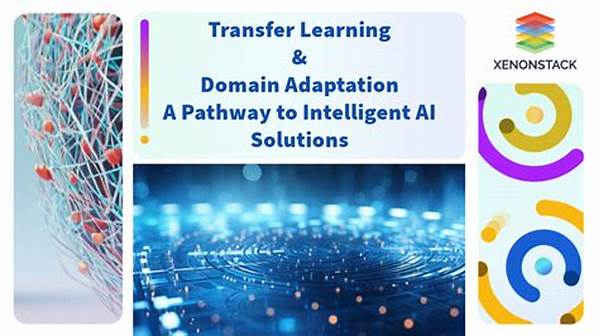In the mesmerizing world of natural language processing (NLP), the concept of domain adaptation via transfer learning emerges like a superhero ready to save the day in scenarios plagued by insufficient data. Imagine you’re venturing into a new domain, like transitioning from legal text analysis to medical reports. Instantly, the question of how to adapt your meticulously trained model to a new but related domain arises. The answer? Domain adaptation via transfer learning in NLP. This tactic has transformed the landscape, allowing models to leverage knowledge from a source domain and adjust to the target domain with remarkable ease.
At the heart of this approach is transfer learning, which allows models to benefit from pre-learned features, drastically reducing the time and computational power needed for training. It acts as a bridge, guiding the model to understand the peculiarities of the new domain without starting from scratch. For businesses, this translates to faster deployment, cost efficiency, and an elevated competitive edge. Whether it’s converting a model trained on open-domain text to tackle niche-specific content or adjusting sentiment analysis tools for financial markets, domain adaptation via transfer learning in NLP has become the go-to strategy.
Exploring Practical Applications
The practical applications of domain adaptation via transfer learning in NLP are both extensive and intriguing. Instituting this strategy in product development not only optimizes resources but also ensures that the models engage with data in the most intelligent manner. Think about chatbots—traditionally, these would require massive datasets to function effectively in new domains. However, with domain adaptation, they can swiftly adjust to different industries, from traveling to healthcare, with minimal manual intervention.
In a world clamoring for efficiency, domain adaptation via transfer learning is more than just a technological advancement—it’s a marketplace differentiator. Tech giants, startups, and researchers are all diving into this arena, aiming to refine and redefine how models communicate across various linguistic landscapes. By harnessing these capabilities, they pledge not just time and money savings, but also advancements in AI’s ability to comprehend and generate human language, fostering innovation across countless fields.
In the ever-evolving landscape of natural language processing, domain adaptation via transfer learning in NLP stands out as a beacon of innovation and improvement. This approach holds the promise of transforming how models adapt to shifting domains, leveraging learned features for optimal performance. Imagine the possibilities when artificial intelligence can seamlessly transition from understanding straightforward product reviews to digesting complex legal documents—this is the realm opened by domain adaptation.
To understand the genius behind this process, consider the analogy of a chef who can cook a variety of cuisines. With domain adaptation, a model trained to perform a specific task in one domain can apply its knowledge to another, just like a versatile chef adapting to cook a new dish. The ingenuity of reusing pre-trained models lies in honing them for domain-specific tasks using less data and resources, enabling rapid deployment and improving scalability.
The journey to decode domain adaptation via transfer learning in NLP is nothing short of spectacular. It boasts not just of improved model adaptability, but also of increased accuracy and efficiency. This is achieved through a blend of techniques that transfer, fine-tune, and customize pre-trained models to new, but related tasks. The concept fuels the imagination, projecting a future where time-consuming training processes are a thing of past.
The Power Behind the Technique
Efficiency and Speed
The efficiency of domain adaptation via transfer learning is its crowning glory. By reducing the need for extensive training data, businesses can achieve faster product cycles and tap into new market opportunities with unprecedented speed. For tech firms, this translates into a compelling ROI and the ability to garner a competitive edge.
Challenges and Opportunities
However, as with any technology, challenges persist. The primary task is finding the balance wherein the adapted model mirrors the specific needs of the new domain without losing fidelity from the original model. But with these challenges come incredible opportunities for growth, innovation, and breakthroughs in the NLP field.
Understanding the intricacies of domain adaptation via transfer learning in NLP requires a detailed exploration of the techniques and strategies employed. Here, we’ve compiled vital insights into how this process fosters innovation across various applications.
The success of domain adaptation hinges on several factors, including the relevance of the source domain, the availability of target domain data, and the complexity of domain shifts. Each of these elements can significantly impact the outcome of the adaptation process.
Domain adaptation via transfer learning in NLP is not a monolithic approach but a spectrum of strategies. Selecting the appropriate method requires a nuanced understanding of the domain, the data, and the end goal. Whether through feature-based adaptation, fine-tuning, or adversarial strategies, each offers distinct advantages and can be meticulously tailored to specific needs.
Advancements in Domain Adaptation
Emerging Trends
The advancements in domain adaptation via transfer learning in NLP are blazing a trail of formidable innovation. One must note the continuous research and burgeoning implementation of new strategies that not only push boundaries but redefine what’s possible. Innovators and developers find themselves at an exciting crossroads, equipped with the tools to elevate model performance across diverse domains.
Deep Dive into Techniques
The rise of adversarial training techniques and multi-tasking models are facilitating groundbreaking results by enabling models to maintain high performance levels across varying data distributions. This constant evolution is what makes domain adaptation a cornerstone of modern NLP tasks, highlighting its immense value in the tech industry.
As we embark on this journey into the realm of domain adaptation via transfer learning in NLP, it becomes imperative to understand key techniques and advances shaping the field. This knowledge will serve as a compass, guiding researchers, developers, and businesses to choose the best strategies for their unique challenges. The promise of transferring intelligence across domains continues to captivate, drawing in researchers and practitioners eager to explore the uncharted territories of NLP.

